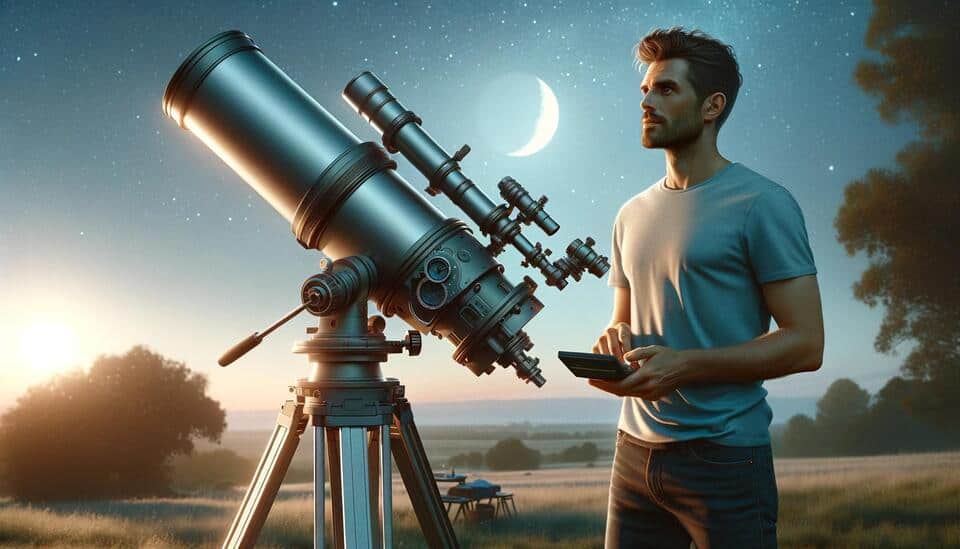The 50x rule in telescopic observation serves as a guideline for amateur astronomers when determining the maximum useful magnification of their telescopes.
This rule-of-thumb suggests that the highest effective magnification of a telescope is 50 times its aperture in inches. For example, a telescope with a 2-inch aperture would have a maximum useful magnification of 100x.
It is crucial for enthusiasts to understand this concept, as exceeding this limit can often result in a decrease in image clarity due to atmospheric conditions and imperfections in telescope optics.
Understanding the limits of a telescope’s magnification is vital for a clear and enjoyable stargazing experience. While the 50x rule is a general guideline, the actual usable magnification can vary depending on several factors, including the quality of the telescope’s optics, the type of objects being observed, and the observer’s location.
Large celestial objects like the moon might allow for higher magnifications, while stars might not benefit as much from pushing the limits of the rule.
But wait…What about in millimeters? Yes, it is a different rule, so let’s keep reading to know the differences.
Understanding the Telescopes 50x Rule
Telescope users should also be aware that atmospheric conditions play a significant role in the rule’s application. On nights with poor seeing conditions, such as when the air is turbulent, even magnifications below the 50x threshold may not yield optimal results. Stargazers should therefore use the rule as a starting point and adjust based on the specific circumstances of their observing session to obtain the best viewing experience.

Selecting the right telescope involves understanding its capabilities, notably its magnification. One guideline to consider is the 50x Rule, which pertains to the maximum usable magnification for a given aperture size.
Basics of Telescope Magnification
A telescope’s magnification (or power) is determined by the combination of its optic’s focal length and the focal length of the eyepiece. The formula for calculating magnification is:
Magnification = Telescope Focal Length / Eyepiece Focal Length
- Telescope Focal Length: The distance between the telescope’s lens or mirror and the point where the image is brought into focus.
- Eyepiece Focal Length: The distance from the eyepiece lens to the point where it brings light to focus.
Learn more about magnification here: Telescope Magnification, Where does it get blurry?
Or are you having trouble with a blurry telescope? Here are Trouble Shooting a Blurry Telescope, Top 6 Fixes
The Concept of the Telescope’s 50x Rule
The 50x Rule is a guideline that suggests the maximum magnification a telescope can effectively provide is 50 times its aperture in inches. To apply the rule:
- Determine the aperture of the telescope (in inches).
- Multiply this number by 50.
Example: For a 3-inch aperture on a telescope:
3" Aperture X 50 = 150x Maximum Useful Magnification
If you are wondering what a telescope aperture is, this would be a great place to start: What is a Telescope Aperture and is There a Best Size?

My Telescopes Aperture is in Millimeters, What is the Max Magnification Rule?
Like with all things metric, the math is easier. The rule-of-thumb in millimeters is 2X.
The 2x Rule is a guideline that suggests the maximum magnification a telescope can effectively provide is 50 times its aperture in inches. To apply the rule:
- Determine the aperture of the telescope (in millimeters).
- Multiply this number by 2 (or double it).
Example: For a 100mm aperture on a telescope:
100mm Aperture X 2 = 200x Maximum Useful Magnification
When Do The 50X or 2X Rules Not Apply?
Simply put, when ever observing conditions are not idea.
However, just consider atmospheric conditions, as they often limit practical magnification below this theoretical maximum. The rule serves as a simple benchmark for enthusiasts to assess the magnifying capabilities of a telescope before observing celestial objects.
Also, if you are trying to observe a larger celestial object, you may be limited to magnification because of narrowing your field of view. The more you zoom in the smaller amount of sky is observed.
Applying the 50x or 2X Rule in Astronomy
The 50x Rule suggests that the maximum useful magnification of a telescope is 50 times the aperture in inches. Of course the 2X Rule is the same but for millimeters.
This rule serves as a guide to achieve clear and crisp imagery of astronomical objects without pushing the telescope beyond its capabilities.
Practical Tips for Telescope Users
- Determine Maximum Magnification: To calculate, multiply the aperture of the telescope (in inches) by 50. For example, a 4-inch telescope would have a maximum useful magnification of 200x.
- Determine Maximum Magnification for mm: To calculate, multiply the aperture of the telescope (in mm) by 2. For example, a 100mm telescope would have a maximum useful magnification of 200x.
- Selecting Eyepieces: Choose eyepieces that provide a magnification close to the telescope’s limit for the best views. Keep a variety of eyepieces, as different magnifications can be beneficial for observing different objects. Always start bigger though and gradually increase (smaller mm’s).
In the examples above I wanted to show that even though you use 2X or 50X, the math is essentially the same because 1″ = 25.4mm so, a 4″ aperture is 4 X 25.4 = 101.2mm. Or an other way of looking at it is, 50X / 25.4 = 1.97X, or basically 2, a rule-of-thumb is rounded math.
Telescope Magnification Limitations and Considerations
- Atmospheric Conditions: Even if a telescope could theoretically reach a 50x magnification per inch of aperture, the atmosphere often limits the practical magnification to a lower level.
- Telescope Quality: High-quality optics can sometimes exceed the 50x rule, but this is the exception, not the norm. Always consider the individual performance of your telescope.
Frequently Asked Questions
This section aims to clarify common queries related to telescope magnification, offering insights into achieving the ideal views of celestial bodies.
How do we determine the best magnification for viewing planets through a telescope?
The best magnification for viewing planets is determined by considering the telescope’s aperture and the 50x rule, which suggests using up to 50x magnification per inch of the telescope’s aperture for optimal viewing on a clear no wind night.
What can I expect to observe with a telescope at 100x magnification?
At 100x magnification, one can expect to see details on planets, such as the rings of Saturn, Jupiter’s major cloud bands, and lunar craters approximately a mile in size, depending on the telescope’s aperture and viewing conditions. Remember that would be max for a 2″ telescope. Just warming up for a 6″ telescope.
Can you explain the importance of the focal ratio in a telescope’s performance?
The focal ratio, denoted as f/number, plays a crucial role in a telescope’s performance; a lower f/number typically allows more light to enter the telescope, resulting in brighter images, which is beneficial for deep-sky observing. See more about f ratio here
How do I calculate the magnification level of my telescope?
To calculate a telescope’s magnification level, divide the focal length of the telescope by the focal length of the eyepiece used, expressed in millimeters. Learn more about magnification by checking out: Telescope Magnification Where Does It Get Blurry?
What are the implications of a telescope’s focal length on its magnifying capabilities?
A telescope’s focal length affects its magnifying capabilities; a longer focal length yields higher magnification when the same eyepiece is used compared to a telescope with a shorter focal length. You may want to read about focal length here and barlow lens here
Are higher magnifications like 1000x achievable and practical in home telescopes?
While higher magnifications like 1000x are technically achievable, they are often impractical for home telescopes due to limitations in aperture size, atmospheric conditions, and the resulting image quality degradation.
Will Montgomery explains how the 50x rule works — and how knowing your scope’s magnification limits can help you avoid disappointing views.


